- HOME
- BEST POKER TRAINING SITES
- POKER GUIDES
- ONLINE POKER ROOMS GUIDE
- POKER NOTES LIVE APP
- MORE
PokerWarmUp.com is an innovative concept that allows players to both create structure and develop continuity in their online poker warm-up routine. It can be used to create and maintain good pre-game habits that will foster positive changes in your results at the table. Its current design is simple, smooth, and very user friendly. The only real criticism I have is that it could be a little more robust.
The bottom line is that PokerWarmUp is a solid idea and good tool right now. There is some room for improvement in the program, but I’m sure that if the developers keep on enhancing it, it will be an even more valuable in the future.
The first step in the program is to lay out your poker goals. Then, you need to answer some hard questions about what’s currently keeping you from achieving them. If you aren’t sure where to start, there are pre-programmed suggestions available for use in each of the three categories: goals, technical game leaks, and mental game leaks. After breaking down the game itself, you are asked to input your major in-game distractions (Skype, Facebook, etc.).
When you begin the warm-up process, PokerWarmUp will take you through all of the items that you have listed. At each stage, you are asked to state these goals and leaks out loud. The idea here is that if you take the time to be mindful of what you are trying to achieve and what is holding you back, you will be more prepared to succeed.
Once this process is completed, you are prompted to close (or remove) anything identified as being a potential distraction. Finally, you are asked to write a message to “future you” to get any last negative or non-poker-related thoughts out of your head. You can then click a button that says “I am ready” (I loved the choice of that phrase!) and begin your online poker session.
A timer tool built into the site will alert you when a designated amount of time has passed, creating an audio/visual cue to stop your online poker session when fatigue might be setting in.

Your responses and history are saved to your account, and, if used consistently, the program will create a body of work for you to see and measure progress. This is a great and necessary feature, but it also inadvertently highlights what is the site’s only real weakness in my opinion. The lack of an outside motivational force providing inertia and incentivizing discipline is a hole in the execution of what is an otherwise solid idea.
The most basic suggestion I could make would be to have some sort of visual cue where you could mark the number of consecutive sessions you have used the program successfully (people like the sense of accomplishment the visual brings).
There is huge potential with PokerWarmUp for a truly interactive service that would provide community reinforcement. I could envision weekly and monthly leaderboards tracking consistent program use with strategy videos as prizes. Alternatively, you could also have the option to warm up with another user who could help you with affirming your goals and being mindful of your leaks.
The possibilities for collaboration within the poker community are endless and really exciting, so it would be great to see the PokerWarmUp developers make at least a basic attempt to harness this latent innovative power of their concept.
Being in the right poker mindset to bring your best game to the table is essential for anyone who wants to play winning poker online in 2015. PokerWarmUp is a great attempt at bringing process and method to an area of the game that can be overwhelming for some, tedious for others, and completely ignored by too many.
The site is clean and logically laid out, easy to use, and can be set up in as little as five minutes. Although it could be greatly enhanced if players could collaborate with one another, it is still a worthwhile tool for players in isolation. It deserves a look by any amateur or pro serious about taking charge of their preparation in order to turn a profit on the virtual felt.
The World Series of Poker is constantly looking for new ways to improve their product and bring new players out to Las Vegas. This year, we saw several positive changes that were well received by players and these changes produced record numbers for attendance.
Officials are already beginning plans for the 2016 WSOP and that includes determining which events should be added to the schedule. One event that ought to warrant strong consideration is a poker variant enjoyed by millions in home games and on video poker machines around the world: deuces wild. Below are 10 reasons why we believe the WSOP needs a deuces wild bracelet event.
You only need to look at the last few years to see that WSOP players love gimmick tournaments. The Millionaire Maker and the Monster Stack began the trend of gimmick tournaments and in 2015, we saw the Colossus and $777 Lucky Sevens added to the schedule.
Deuces wild could be yet another gimmick event added to bring in players looking for a fun alternative to the standard grind that is the World Series of Poker. We’d venture that some of the pros would even enjoy a deuces wild game to break up the monotony of the standard Hold’em game.
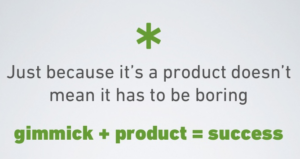
When you get pocket deuces in Texas Hold’em, you typically won’t win unless you improve to a set or better. If the WSOP holds a deuces wild bracelet event, they become the immortal nuts.
When you’re dealt pocket ducks in a deuces wild game, the absolute worst hand you will finish with is a set. If the board pairs or another deuce hits the board, your worst hand is quads.
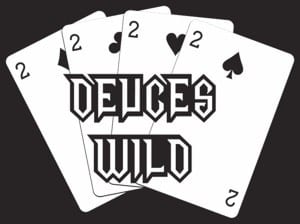
Nearly every imaginable situation possible will give you the winning hand. The only exception is if someone has a pocket pair, hits a set on board without an over card, or a straight. You will then chop.
Imagine how many ways you can play a hand knowing you cannot lose?! Time to start practicing your pocket deuces strategy.
Imagine the promotional opportunities available for this event. Deuces Gone Wild is the first tag line, playing off the popular “Girls Gone Wild” video series. Poker players were “Born to be Wild” is another fun tag line.
“Drop a Deuce” on your favorite pro is another unique tag line that could be used. The point is that the clever advertising executives at the WSOP could have a field day promoting this event.
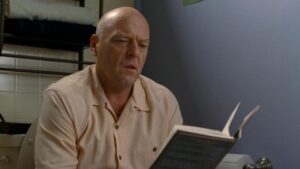
Just droppin’ a deuce…
A deuces wild bracelet will reignite the age-old debate of luck versus skill. While it is true that wild card games are a tad less skillful, just how much does the dynamic change?
You math experts out there can work out the odds knowing that four wild cards only are available in the game. Of course, that is assuming that there are no qualifiers such as “only hole card deuces are wild” or that “deuces can only play as an ace or complete a straight or flush”.
Will the dynamic change enough to make the game unplayable for the average pro or will it just make some players work on new strategy to counter for the increase in variance?
The World Series of Poker strives to reflect the poker world in terms of what is being played online and in brick & mortar casinos. However, many amateur poker players around the world play wild card games, and yes, some of these wild card games are complete luckfests. In addition, plenty of gamers with some online gamble in them head to places like Mansion Casino to play video poker, including the aforementioned wild games.
With that said, in some games, such as deuces wild, the luck factor is a bit more controlled. Including deuces wild as a bracelet event would be a way for the WSOP to have its brand identify better with the average home game poker player. This may give them an added incentive to come out to Vegas and play at the WSOP.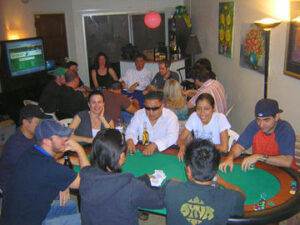
One great reason to try a deuces wild event is that it will play a lot faster than your standard NL Hold’em event. Rather, it will play similar to a PL Omaha tournament.
This means you will see a lot more drawing thanks to the wild cards and players suffering bad beats when their standard hands fail to hold against the various wild card combinations.
The great thing about a deuces wild event is that you can tinker with the structure to reduce the perceived “luck factor.” The standard event would have four wild cards available each hand. This may be too many wild cards for some to be comfortable playing.
Fortunately, there are other options. For example, you can put a qualifier on how the wild card can be used. In some joker games, the card can only be used as an ace or to complete a straight or flush. The same wild rules could be applied for deuces wild. When used as a wild card, they complete straights, flushes or can be used as an ace.
Another option would be only make it wild if the card is dealt as a hole card. In Mexican Poker, for instance, the only time a joker is completely wild is when it is dealt face down. Using the same rules, only hole card deuces would be wild.
It’s no secret that Allen Kessler is a big fan of video poker and he’s of course played deuces wild video poker on multiple occasions. He would be the perfect person to serve as a special tournament sponsor for a deuces wild WSOP bracelet event.
Such a dilemma every deuce worth $500. Plus im guaranteed at least 4 of a kind. I took the sure $1875; chickened out pic.twitter.com/XNcBm35qC0
— Allen Kessler (@AllenKessler) July 22, 2015
In fact, Allen could become the WSOP’s mouthpiece for the event, explaining to players not just how to play deuces wild but also why they should play. They may even allow him to install a “Chainsaw approved” structure for the event.
Read and listen to our interview with Allen Kessler.
A deuces wild event isn’t event a completely new concept for the live poker world. In fact, the EPT Vienna decided to attempt a deuces wild tournament in 2014 and Chad Holloway of PokerNews played in the event.

The WSOP can look at what the EPT did, incorporate what they like, and ignore what they don’t. A blueprint is out there in terms of how to run a deuces wild poker tournament event and the WSOP can improve on the concept… and offer a coveted bracelet.
Believe it or not, a deuces wild bracelet event in 2016 would not be the first time in WSOP history that a wild card game was spread. In 1986, a $5,000 NL A-5 Lowball with Joker was offered on the schedule.
Mike Cox eventually defeated Jack Keller to take the title and $118,000. The event was dropped the following year. While wild card events were short lived, they were part of history and could be once again.
The World Series of Poker continues to grow from strength to strength. Part of maintaining that growth trend is the need for constant innovation and infusions of excitement. For the 10 reasons enumerated above, plus many more you can probably think of yourselves, the time is ripe for the deuces wild poker discipline to be introduced as a bracelet event at the WSOP in 2016.
Vegas, early July. You’ve been at the Rio for a full month, grinding hard, pining for that elusive WSOP bracelet. Fourteen-hour days blur together. You stop thinking. You stop showering. After another bad beat (do aces ever beat kings?) you drag yourself from the Brasilia Room to the toilet to the Poker Kitchen, where you force another greasy, overpriced burger down your throat. Staggering towards the Amazon Room, you feel like…a zombie or something.
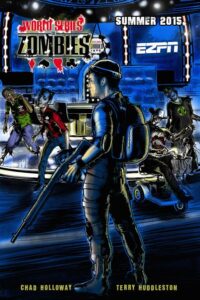
Welcome to Chad Holloway’s World Series of Zombies, a 16-page comic book inspired by the long hours that players (and reporters) log at the WSOP. Holloway, a senior editor with PokerNews, is no stranger to the slog. This is his sixth summer stalking the drafty Rio hallways. “I’m a big comic book fan. I’m obviously a big poker fan,” Holloway told me at his WSOZ booth. “So when I decided I’d like to do a project to combine the two, I thought to myself: why not set it to the backdrop of a zombie outbreak during the World Series of Poker?”
Read and listen to our interview with Chad Holloway.
The story begins in a packed Amazon Room during the Main Event, where thousands of unhygienic grinders compete for money. A generic-looking dude named Dalton is in a pot with Mike Matusow, who suddenly grimaces, folds his hand, and limps towards the exit. Is he tired? Tilted? Hungry for another pricy burger? Nope, he’s giving new meaning to the phrase “so sick.” When Mike the Mouth returns he’s—GASP—a zombie!
For the rest of the slim narrative, Dalton and other prominent poker pros battle the zombie horde. “I wanted to use pros that the general public—not just hard-core poker fans—would recognize: people like Mike the Mouth Matusow, Daniel Negreanu, Phil Hellmuth,” Holloway said. He throws in a few lesser-known faces, too, like “Mad” Marvin Rettenmaier, David “Doc” Sands, and Allen “Chainsaw” Kessler. Yes, Kessler gets to wield a chainsaw.
Read and listen to our interview with Allen Kessler.
I’ll admit it: I’m not much into zombies. Give me a Hobbit or a lightsaber instead. But I am glad that, like Shaun of the Dead, WSOZ is campy in all the right ways. My favorite moment is when Vanessa Selbst downs her foe with a familiar gardening tool and says, snarling with glee, “You can never beat the rake!”
Another bright spot is WSOZ’s illustrations. Terry Huddleston does a fine job of bringing these poker personalities to life (and to death). And Erik Reichenbach, an artist and Survivor contestant, completed a variant cover featuring Daniel Negreanu—a timely tribute for the almost-November-Niner.

WSOZ is essentially a mashup of scenes from comic books, film, and pop culture. This is both a strength and a weakness. The ending, for example, features an amusing showdown between a zombified Phil Hellmuth and the book’s hero—could it be anyone else?—Phil Ivey. After Hellmuth delivers his trademark “I can dodge bullets” line, Ivey, in a nod to The Matrix, extends a double-barreled shotgun and calmly responds, “Dodge this!”
For casual readers unfamiliar with or indifferent to poker, there’s nothing new here. But Holloway wrote this book for and to the poker community, and folks within this niche will be entertained. Go ahead, pick it up!
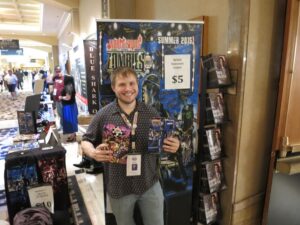
Holloway hawking his WSOZ comic at the WSOP
World Series of Zombies evokes the madness and monotony of those drafty Rio hallways: you’ll remember why you booked that ticket to go bracelet hunting, why those bad beats sting with special suffering (seriously, do aces ever beat kings?), why you’re done with sweaty summers in Vegas….
…and why, next year, you’ll go back.
Digital copies of World Series of Zombies are available online at Comixology.com for $1.99.
RunGoodGear has also be printed 250 limited edition shirts featuring the cover of the comic book.
There’s a multitude of recreational and semi-pro poker players dreaming of “making it”, i.e., financing themselves completely from card playing, without an additional source of income or a day job.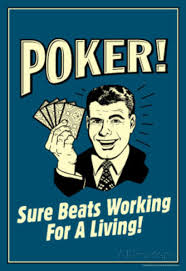
In their naive, gullible, dreams, they wake up around noontime, grab a bite, and run a quick online poker session over the Internet. Come night time, they pack their cash-filled wallet, and hit the nearest casino, if they don’t have anything else planned out. These credulous individuals are often times avaricious, as making a living from poker is insufficient to them. They want to be filthy rich. Dan Bilzerian rich.
Nothing could be further from the truth than the picture painted above. Such a lifestyle could be somewhat feasible for a highly-gifted poker prodigy, but for us non-Ivey humans, it’s highly unlikely to happen.
Professional grinders are bound to treat poker like any other business generating the majority of their income.
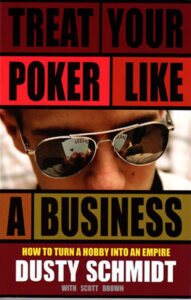
They know that the following nine business (and poker) pillars affect their income to a greater extent than their actual game play:
Opportunism: It’s easy to simplify opportunism in poker by calling it “game selection”, or “table selection”, but there’s more to it. Much like the world of business, in order to be aware of the best options in the market, a professional grinder must do several things, including:
Diversification: In both business and poker, one-trick-ponies miss a key element, namely longevity. One-trick-ponies like Blockbuster eventually fail, much like poker players who always play the same type of games at the same place. It’s good to prepare for a “doomsday scenario” where that one trick will no longer be applicable. In other words: learn how to effectively change gears.
Specialization: As with the world of business, which is becoming increasingly competitive, the level of poker, online and in brick and mortar cardrooms, is improving drastically. To have a real edge over the field, most professional grinders choose to specialize in one particular variation of the game. Note that this should still be done in conjunction with diversification.
Self-awareness: By keeping appropriate documentation, a good player can map his strengths, and weakness, in the same fashion a business owner would perform a regular SWOT analysis. This enables a poker player to analyze opportunities better (projecting revenues and risks), and also seek for ways to improve his weak spots. Key takeaway: take good poker notes.
Grinding: Particularly at their earliest stages, risk minimization plays a huge factor with businesses. The aim of a poker player is to move forward slowly and carefully, without taking excessive risks, with high hopes of making large amounts of money. Risk taking can be achieved at a later stage, once your bankroll, and profit-margins, are large enough.
Financing: Since the grinder’s goal is to choose the most profitable games around, while risking a pre-calculated amount of funds, financing is sometimes required. Staking deals are thus quite common, almost as much as equity business funding is. The devil is in the details though, as favorable terms for stake selling could make the difference between a winning and a losing series of sessions. In addition, strong business relationships (i.e., reputation) could earn one interest-free loans in times of need.
Bankroll separated from personal finance: As with businesses, it’s always advisable to keep separate bank accounts for one’s personal affairs and one’s poker bankroll. Sadly, this is a rule not always kept to by aspiring poker players and veteran grinders. The second best option is to adjust the personal finance requirements to the bankroll, making sure expenses are reduced when poker hardships come along.
Projection and future planning: It is fairly impossible to run a business, even a sole tradership, without projecting earnings and expenses over the near future. In poker, one should be sure to do this as well. Playing poker for a living assumes an inherent risk, but that risk increases tenfold when one fails to set clear expectations and compare achievements and failures to a pre-set plan.
Vision: A business without a vision can never progress, much like grinders would never make it onto the pro circuit without one. A grinder drifting aimlessly, playing the same stakes, without increasing his profitability, will, in a best-case scenario, continue keeping his head above water. There has to be some kind of a game plan, backed up by milestones verifying that plan is indeed in motion.
While there are clearly many similarities between trying to make a living by playing poker and running a business, there’s one last bullet to take into consideration that’s unique to poker.
Poker is gambling.
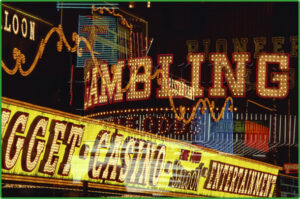
Even though poker is a skill game, one cannot deny that luck plays a huge role in the outcome.
This means that one could follow a rigorous plan, improve their skills, and still lose. Losing over a long period of time will undoubtedly translate into financial, and more importantly, mental, hardships. When someone’s entire income is dependent on something as volatile as poker, he must maintain nerves of steel, coated in alligator blood. These are inborn characteristics, which are absolutely necessary to “make it”. If you do not possess them, or cannot develop them, you won’t be able to make a living from playing poker.
The Aria Super High Roller Series will hit television starting on July 29 and will run throughout the fall on Poker Central and NBC Sports Network. The series included a Celebrity Shootout, Super High Roller Cash Game, and a $500,000 buy-in Super High Roller Bowl tournament. The Super High Roller Bowl attracted 43 poker pros and businessmen to the Aria for one of the most epic poker events… ever.
I had media credentials to the latter two of these events thanks to Cardplayer Lifestyle poker blog founder Robbie Strazynski and Sandra Yacura of Poker Central. It was very cool getting to stand on set while legendary poker pros like Daniel Negreanu, Phil Ivey, Scott Seiver, Antonio Esfandiari, and others competed for millions of dollars in the Super High Roller Bowl.
After the field narrowed down to just two players, Brian Rast beat out Scott Seiver in an exciting heads-up battle and took home a cool $7.5 million for his efforts. Also at the final table was the legendary Erik Seidel. It seems like he cashes in darn near every high roller event he plays in. It was a pleasure to watch him play in person.
All of the events that comprised the Super High Roller series are being produced by Mori Eskandani of Poker PROductions. You’ve probably seen tons of his work over the years (e.g., High Stakes Poker, Poker After Dark, etc.). I got to meet Mori while covering the events and he was gracious enough to answer some questions about the production of the Aria Super High Roller Bowl and the future of poker on television. I hope you enjoy!
Mori, thanks for joining us, how are you?
My pleasure, thank you.
Let’s start with the Super High Roller Cash Game. You previously produced High Stakes Poker, which was a very popular cash game show on Game Show Network a few years back. How will this one compare to High Stakes Poker?
I’ve been asked that question before. All cash games are inherently the same. It’s people who play every day. We try to go “into their office” and catch them while they’re playing. Poker After Dark and many European cash games were produced for television. High Stakes Poker was the first one, which is why it sticks in everybody’s minds.
The Super High Roller Cash Game featured today’s cash game players. The stakes are a little bit higher than they were on High Stakes Poker.
Comparison-wise, I would say it’s “just another cash game”.
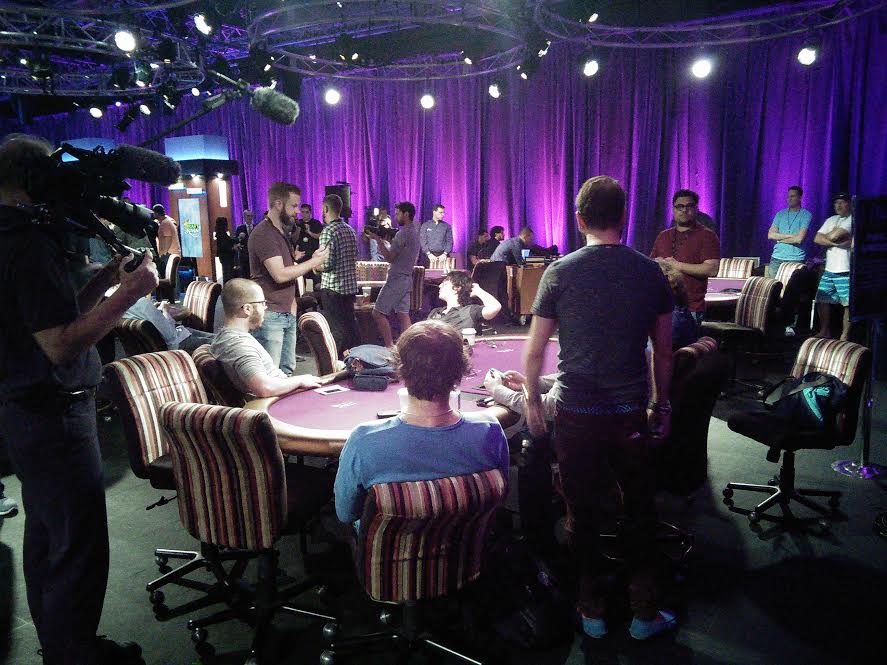
How did you go about selecting the players for each day?
For cash games, it’s almost as though the players select themselves. You go into big games and see who is playing. They’re not all pros, it’s also recreational player businessmen who like to put their money in big cash games; it’s a thrill for them. We try to catch some of those guys.
Of course we also try to catch some of the best known cash games players, like Doyle Brunson, Johnny Chan, Patrik Antonius – guys who are mainly cash game players. We try to bring a mix of guys who have been playing for a long time as well as guys who are new on the high stakes cash game scene.
Before Black Friday, poker on TV was very popular. But outside of the WSOP and niche shows like Poker Night in America, poker is pretty much gone from mainstream television nowadays. Do you envision the Super High Roller Series helping to bring poker back into the limelight?
It’s always nice to have the network get behind the programming. In this case, it’s Poker Central getting behind the Super High Roller series; whatever events we are producing for them. Once you have the network behind you and their salespeople finding sponsors for the show, air dates, and other things like that, it’s a big plus.
For the WSOP, ESPN is a huge part of it. The same was true of High Stakes Poker and Poker After Dark. With this one, obviously we have Poker Central, the 24/7 poker network. So, I’m looking forward to many years of Super High Roller events for them.
When poker became popular on TV a dozen years ago, the personalities were great. Hellmuth, Negreanu, Matusow, and others always put on a show. Do you feel that the new school players have the same sort of charisma to make the show entertaining?
The younger kids, most of them have been brought up on the Internet, where there’s so little interaction. Maybe they have to get used to live games a little more. In the old days when we taped, part of our work as professionals was to entertain the recreational players. If they got into the game, we made sure they had fun.
You come to the game or to a poker room and you see a table that is full of laughter and having fun, and you would want to get into that game. Being entertaining was part of the game of old school poker.
Kids we’re filming now may be plenty entertaining, but maybe not to the same degree as we’ve seen from the older players.
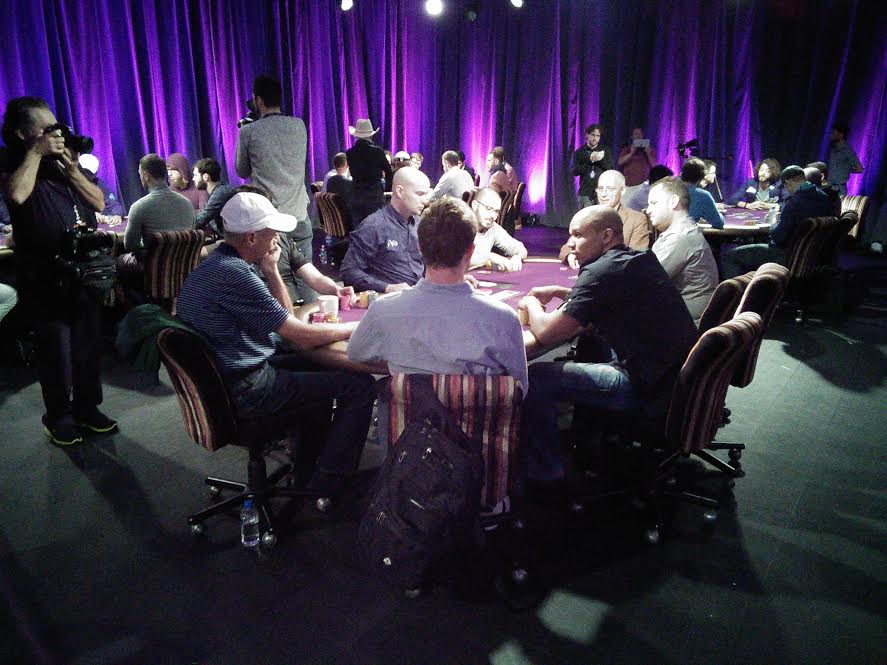
I got to see the $500,000 buy-in Super High Roller Bowl up close and I can’t wait to see how you put the tournament together for TV. Can you give me a hint of some features I didn’t get to see in person, but will when it airs on NBC Sports Network in the fall?
Most of it is going to be the poker hands and the poker tournament. The features will be geared towards introducing the new players. There will obviously be a ton of new faces. Our poker role is to let people know who they are. The issue is that you’ve got a lot of superior players who, one way or another, have not made final tables of big tournaments, so you don’t get to know them.
So, again, we’ll be focusing on interviewing new players.
A dozen or so players, guys like Tom Dwan and Phil Hellmuth, who originally committed to the Super High Roller Bowl didn’t play. Were you at all disappointed with the turnout?
I was not. Look, it’s a $500K buy in. If 40 players play it’s a huge win. The fact that it went over, it’s a testament that poker at the highest levels is still alive and kicking. It was nice to see that many players. A $21.5 million prize pool, I wasn’t disappointed one bit.
I know Tom Dwan wasn’t even in the country. Next year, poker players will know that this event is here to stay and they’ll plan better for it.
When producing a poker series for TV, do you try to influence the players to keep the banter at the table interesting or do you just let them do their thing?
I encourage them to talk a little because filling the silence is tough. You can only do so much commentary, unless of course it’s a huge hand, which doesn’t necessitate saying much. So, I encourage players to be themselves, which usually leads to a lot of table talk.

Any chance of bringing back the National Heads-Up Championships, High Stakes Poker, or Poker After Dark in the near future?
I’ve always said that there will be more poker shows in the future than in the past. That means a whole slew of new shows will come. The bottom line is what our government lets us do with Internet poker. If they allow people to play online and create more interest, we’ll obviously be able to do more of these shows in the future. I know the shows you mentioned were VERY popular. Those shows will be first in line to come back, someday.
About those big companies that sponsored that poker TV, like PokerStars and Full Tilt Poker… I don’t know how closely you follow the U.S. government regulation stuff, but do you have any optimism for those sites reentering the U.S. market and maybe that helping bring back poker on TV?
I don’t want to focus on the sites. I want to focus on the game. It’s not something that can be taken away from the fabric of our lives. It’s part of our culture. It’s here to stay. It’s not a fad. Millions of people will keep on playing. I’m sure our politicians and organizers will find a way to make this work.
When that comes to life, it’s not just going to be the online sites to take sponsorships in poker. We see it already right now – many sponsors aren’t connected to poker. So, I think it’s going to take a long time, but eventually it will come.
Can it hit its peak popularity again like from 2003-2006?
Of course! If lawmakers make online poker happen again, of course the game will boom once more. I don’t see any reason why it wouldn’t, especially if the big casino companies use their clout to get behind it. These guys know what to do with poker and how to market it and get us going.
In closing, can you tell our listeners and readers who the commentators are going to be for the Super High Roller events?
Kara Scott and Jesse Sylvia are going to be doing the Celebrity Shootout and the Super High Roller Bowl. The cash games commentators are yet to be announced.
Alright, we’ll wait for that news. Thank you Mori for joining us today; I appreciate it.
Thank you so much; you too!
Wondering what it’s like to play in your first World Series of Poker Main Event? Ask Steve Bierman. A landlord and the owner of an insurance company in New Orleans, Steve regularly plays $1/3 and $2/5 No-limit Hold’em. He’s known, at Harrah’s New Orleans, for his friendly table chatter and a pugnacious playing style. Last December, Steve won a free entry into a satellite whose prize was a $10,000 ticket to poker’s most prestigious tournament. He outlasted 70 opponents to win the seat.
I first met Steve at Lager’s International Ale House in Metairie, Louisiana, where we talked poker with “Wild” Bill Phillips, Steve’s friend, coach, and co-founder of gulfcoastpoker.net. Determined to ready himself for the Main, Steve trained with Bill and played in Las Vegas for a full month. Just yesterday, during the first break of Day 1B, when swaths of grinders and fans and reporters swarmed the Brasilia Room of the Rio, I spotted Steve and asked him about his first WSOP experience.
Ben Saxton: “This is your first Main Event! This is huge. Why don’t you walk me through your day to let me know how you prepared.”
Steve Bierman: “Slept till 6 a.m., got up, ate breakfast. Went back to sleep, got back up at 11.”
Nervous?
Extremely nervous. I’m telling you, Ben, I was sitting at the table for an hour and a half just focusing on my breath. That’s all I could do.
What was your mentality going in?
I generally play pretty loose early on. Most people don’t realize I’m an aggro, but with these levels as long as they are, I decided to tighten up.

So you’ve been playing pretty tight?
Very tight. Extremely tight. I’ve been throwing away jack-king, ace-eight. Hands that I’d normally play.
How’s your table?
I’ve played enough tournaments to know that your table draw is hugely important, and this is a good table draw. I feel like everybody’s playing ABC poker. I’ve only got one aggro. Unfortunately he’s to my left. I’ve noticed people are a lot more serious. This is unlike any other tournament I’ve ever played: everyone’s dead serious.
You’re at 36K, which is up a bit from the 30K starting stack. Any interesting hands so far?
I had pocket queens, raised preflop, and then the aggro to my left reraised me. A lot of times I’ll reraise there, but I just flatted. Flop comes out jack-high, two low cards, rainbow. I check, he bets 1,200, I call. Turn comes, no damage. I check, he bets again. Now I’m thinking he has kings or aces, but I’m gonna call anyway. Of course the river’s a queen. And—I think I might have screwed up here—I bet 4,000 on the river, and he folded.
I don’t know. I think if he has kings or aces he’s paying you off.
He said he had aces.
Did he really? Wow. I don’t really believe that.
I’ve got a feeling he’s a pro. I’d love to know his name.
You feeling good right now?
I’m feeling great. My friend has been sending me texts. Look at what he wrote to me after I told him I was nervous (see image below): “Courage is not the absence of fear but the mastery of it. You have been practicing for this. Your time to shine.”
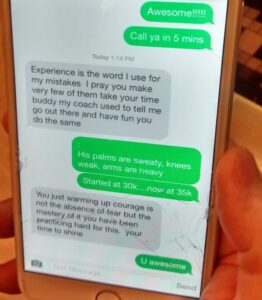
**
After six more hours at the tables, Steve looked excited and a bit tired towards the end of the evening. His stack had grown to 44K at 150/300 blinds. As soon as he found me on the rail, he was in mid-sentence about a confrontation with an aggressive player in seat one.
**
Ace-eight suited. I make it 700, my nemesis makes it 1,500 on the button. This is the third time that he’s raised me on the button. He can’t have a hand every time! So I called him and the flop comes out Ace-King-Ten, two clubs. He bets 2,000. I felt like it was a weak bet, so I made it 7,000. He makes it 15,000 and I fold. What are you thinking?
I’m thinking you put yourself in a pretty tough spot there.
Where was the mistake?
I don’t know… Raising the flop has to be bad, I think. You’re never getting value from worse hands when you make it 7,000. So I think you can just check-call the flop and go from there. But it’s a shitty spot. It’s a very shitty spot. You’re behind so many hands except for his bluffs. Even a hand like jack-ten has a pair and a gutshot.
That was the only mistake I made all day. I had to tussle with the one seat. And Bill told me, too: “Just leave him alone!”
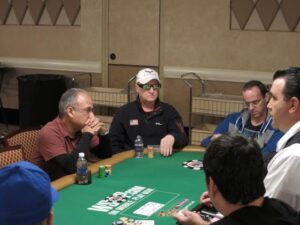
Steve playing in the WSOP Main Event
How are you feeling?
I’m feeling great.
Nerves are gone?
Nerves are gone. I’m feeling good. Getting a little bit tired, but I’m all right.
Two more hours to go, right?
Yeah. I can’t see me not making Day Two.
You’ll make it.
**
Steve finished the night with 28.5K at 200/400 blinds. He’ll play Day 2B tomorrow. Steve will be posting updates on twitter @NOLACorvette.
I write this as I prepare to enter my first WSOP Main Event in less than 24 hours. While I love playing live poker, and I’ve even appeared on Poker Night in America, I miss playing online. Before Black Friday, I would play several hours a week, but always tournaments or low-stakes cash games. The reason that I stayed in the lowest stakes is that, as a computer security professional, I know too much to be comfortable online. I simply don’t trust my own computer, mostly because I know how easy it is for an attacker to place malware on my machine that I would never notice. In fact, I could do it to others myself. It’s actually quite easy.
Be sure to check out Cardplayer Lifestyle’s online poker security section.
So, this past year, I’ve been on a crusade to make online poker more secure. To that end, I wrote an Op-Ed that was published in my local paper, the Baltimore Sun, called “Online Poker: Deal Me In”. To actually address the problem, I’m building a prototype online poker system, using some open source poker tools, where your hole cards stay off of your computer. To illustrate, here is a simple and (hopefully) humorous video that explains why I am doing this and how my system works.
I hope you find the above video to be informative and useful. If my project, or online poker security in general, is something that interests you, I’d love to hear from you. You can reach me at [email protected].
—
Ed. Note: While we primarily write about poker here at Cardplayer Lifestyle, it should be noted that cyber security issues of course extend beyond online poker rooms to online casinos as well. The relatively new online casinos that operate out of New Jersey, for example, or those more established ones that accept players from other countries around the world, go to great lengths to ensure that player funds are safe and that all gameplay is fair and secure. With online poker, however, there’s the element of playing against other players, as opposed to just the house. That’s why we support ideas such as those proffered above by Professor Rubin, which will undoubtedly enhance the security of online poker play.
Hop into Doc Brown’s time machine with me, back to the year 2005. Chris Moneymaker was just two years removed from his improbable run in the WSOP Main Event (BTW, here’s my interview with Chris from a couple weeks ago). Online poker was cool, and the game of poker had finally become ‘mainstream’. Every mainstream media outlet – Fox Sports, ESPN, NBC, GSN – wanted a piece of the action, and who could blame them? Advertisers were lining up to sponsor televised poker events such as High Stakes Poker, the World Series of Poker, World Poker Tour, and Poker After Dark (my favorite).
Poker just wasn’t ‘cool’ prior to Moneymaker’s big win in 2003. If you played poker for a living back in the 1990s, your family probably disowned you. If you played poker for a living in 2005, your friends and family probably wanted to live vicariously through your lifestyle. That’s because they saw poker on television non-stop and got to see how exciting and potentially profitable this game could truly be.
What really drew people into the game of poker back then was the personalities. All poker fans know the guys I’m talking about: Mike Matusow, Phil Hellmuth, Daniel Negreanu, Phil Laak, Gus Hansen, Antonio Esfandiari, Phil Ivey, Jennifer Harman, Johnny Chan, Doyle Brunson, etc. These superstars not only knew how to play poker. They also knew how to entertain. When the cameras were rolling, they put on a show, whether it was Matusow feuding with Shahram Sheikhan at the 2005 WSOP or Phil Hellmuth’s many epic blow ups, poker was more than just a game – it was a spectacle.
At some point over the last decade, poker became “just a game” again. By 2011, poker was no longer mainstream. High Stakes Poker folded, as did Poker After Dark. ESPN limited its WSOP coverage to the Main Event. Much of that can be attributed to ‘Black Friday’, but I think the writing was already on the wall. The game of poker, save for ESPN’s WSOP coverage, is no longer must-see TV because there are no big TV events to see.
That’s all about to change thanks to Poker Central and the Aria Super High Roller Bowl. I spent the last three days sitting in on set for the Aria Super High Roller Cash Game that will be televised on Poker Central this fall. Additionally, I’ll be there for the $500,000 buy-in Super High Roller Bowl that begins today, which will air on NBC Sports Network starting August 25th.
If you watched the live stream on Twitch of the three days of cash game play, you probably noticed something: today’s top poker pros have very little in common with the players many of us grew up watching on TV. They differ tremendously in terms of personality and style of play. Day 1 of the Super High Roller Cash Game ($250,000 minimum buy-in) featured an old-school table. Phil Ivey, Antonio Esfandiari, Jennifer Tilly, Doyle Brunson, and Jean-Robert Bellande headlined the action.
Ed. note: Missed the live stream? You can catch replays on Poker Central’s Twitch channel anytime.
It was a pleasure to watch this group in person and I’m sure that once the producers at Poker Central edit the tape, we’ll get to see a show that closely resembles High Stakes Poker. Most of the players played as expected. Ivey was, surprisingly, tight. Jennifer Tilly was, surprisingly, aggressive and reckless. Esfandiari played his usual wild but controlled style of play, and Jean-Robert was up and down all day, like he always seems to be on TV. Except for Ivey, the players kept the game lively. It was evident these poker stars have experience working the camera.
Day 2 was different in many ways. The game featured mostly new-school poker studs such as Scott Seiver, Andrew Robl, Doug Polk, Dan Colman, and Sam Trickett. These are the players whose playing styles many around the poker community attempt to emulate now. The old-school players don’t get much respect from today’s younger players. The Day 2 table is considered “superior”. These guys play the hyper-aggressive style that became popular a few years ago. They attack pre-flop, flat call light in position on the flop, and almost always continuation bet.
The Day 2 table was lively, but it was obvious they don’t have the same charisma as the Day 1 competitors. I don’t mean to offend, of course, but it’s just to be expected considering that the Day 1 table was filled with poker players who had extensive experience playing in front of TV cameras and playing to the viewing audience. With that said, I thought Scott Seiver did a good job of keeping the table talk interesting. Beyond being one of the best players in the world, Seiver’s personality is quite simply made for TV. Without him at the table, I’m not sure Day 2 would have been entertaining to watch. I know some poker players don’t care for his talkative personality, but I like it.
Day 3 featured an eclectic mix of players. Bobby Baldwin and a few other old-timers hit the felt, along with a couple of ‘youngsters’ such as Jean-Robert Bellande and Antonio Esfandiari. I was pleasantly surprised with this table. They were very entertaining. Specifically, Bill Klein and John Morgan were a couple of “old rich dudes” that constantly made me laugh.
Rick Salomon also made his way to the table on Day 3. If you’re unfamiliar with Mr. Salomon, he’s a bearded weirdo who became famous for his leaked sex tape with Paris Hilton and marrying crazy famous women such as Shannon Doherty and Pamela Anderson. He’s an entertaining player because he’s hyper-aggressive and is prepared to call anyone down with junk. The best hand of the day involved Salomon and Bellande. Salomon made a donk call in position on a queen-high flop with J-10 suited (no draw, no pair). He hit a runner-runner flush and won a massive pot against Bellande. You can imagine that Bellande’s reaction wasn’t pleasant.
Salomon isn’t a new-school player in terms of age (he’s 47), but he does play a similar style to the new-school breed. He is ultra-aggressive in position. It’s rare to see him fold to a bet on the flop even if he completely misses. He bluffs… a lot. He is aggressive pre- and post-flop and plays a lot of hands. The old-school poker mentality is quite a bit different. That’s not to say the old-schoolers only played the nuts, but they were more selective pre-flop and didn’t call down light as much.
I thought it was really cool to see the contrasting styles of play and personalities each day. I don’t know if Poker Central casted the tables intentionally or not, but it’s going to make for some epic television on their network this fall.
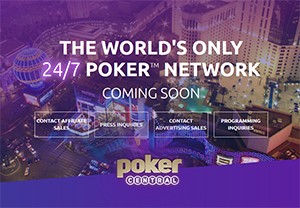
I caught snippets of the live stream on Twitch when I wasn’t watching live on the TV set at Aria. The commentary was solid, but viewers were unable to see hole cards. I know that this sort of ruined the enjoyment for many viewers. With that said, the beauty of episodic, professionally produced poker TV shows is that we’ll get to see the hole cards and play right along with the pros.
Mori Eskandani is producing the show and, based on his past history (Poker After Dark, High Stakes Poker), I know he’s going to get this right. I got to meet Mori on the set and he was very friendly and helpful. He even offered to help find me a good place to sit so that I could take pictures of the action, some of which I included here in my write-up.
Everyone at Poker Central and Aria have been super accommodating. It was exceptionally cool, as a poker fan, getting to watch these poker celebrities playing for millions of dollars right up close. I can’t wait to see it on television this fall, and I’m equally excited to watch the Aria Super High Roller Bowl… which has just started right as we’re publishing. I’ll check in with you guys again soon!
Sound familiar? If not, then you’ve been missing a fascinating self-portrait of the professional poker lifestyle. In June 2014, Tim Watts drove from Jacksonville, Florida to Las Vegas. His goal, along with building a bankroll and escaping an exhausting career in the restaurant industry, has been to document his life in a series of YouTube vlogs. Holding a Canon point-and-shoot in his outstretched right hand, Tim talks to himself—and to us—as he roams Vegas. He edits and uploads this content to TheTrooper97Vlog, which has attracted thousands of subscribers.
When I first watched Tim’s vlogs, what intrigued me wasn’t the repetitive content—long drives around town, endless cups of Starbucks coffee, strolls through casinos and parking decks and poker rooms—but what was missing. I had questions:
 I spoke with Tim on a steamy June afternoon at the World Series of Poker. We met, appropriately, at a Starbucks inside the Rio, where he sipped iced coffee and wore a black flat-brimmed hat that shouted VILLAIN. As I turned on my recorder, Tim glanced at an empty table beside us and pondered creative opportunities of his own.
I spoke with Tim on a steamy June afternoon at the World Series of Poker. We met, appropriately, at a Starbucks inside the Rio, where he sipped iced coffee and wore a black flat-brimmed hat that shouted VILLAIN. As I turned on my recorder, Tim glanced at an empty table beside us and pondered creative opportunities of his own.
Tim Watts: “I should put my camera right there. We wouldn’t even need audio, we could—oh, but I don’t have a tripod.”
Ben Saxton: “We can try if you want to.”
“It’s fine. I’m just thinking about what new content I can put in the vlog. Why don’t we—we’ll worry about it later.”
“Sure. So I’d like to start by hearing about how you got into poker, since the vlogs start after you got into the game.”
“My pathway to poker started a long time ago, way before YouTube was created. I don’t really know where to start, but I will say that I used to gamble. I used to gamble a lot.”
“What were you gambling on?”
“Video poker, mostly, in Myrtle Beach, South Carolina.”
“Is that where you grew up?”
“I grew up in Greenville, South Carolina. There was quasi-legal video poker in the state, and I hit four deuces one night and won $400. That was all it took for me. I was hooked.
Gambling is its own story, which I’ve explored psychologically for years. And I have some good theories as to why I gambled in the first place.”
“What did you find?”
“Consciously, my attraction to gambling was escapism. I never drank, I never used drugs, I never smoked. I had worked for years in the restaurant industry, where everybody does those things. In Myrtle Beach, while everybody was at the bar drinking after work, I was at the big three-seater blackjack machine getting a thrill and chasing a big win. Now I know—and I probably knew then, subconsciously—that even if I did win big I would keep gambling and lose it all.”
“Was the attraction to poker because of the gambling nature of the game, the strategy, or the money? Or all of those things?
“I saw Rounders in 1999 because it was gambling-related. I had read tons of gambling books, and most of them explained that poker is a game that can be beat. I wanted to beat blackjack or video poker or craps, which were all fantasies. But knowing the reality that you can beat poker, between Rounders and the poker boom [in 2003], I thought that I could probably make it if I moved to Vegas.”
“How did you make the transition to poker?”
“In 2005 I got a job at Chophouse 47, an upscale casual steakhouse in Greenville. One of the managers told me about a home game, just two blocks from my apartment, in some guy’s garage. So I went there and everyone saw I that was a natural at handling cards—at this time I was really into gambling. I would deal blackjack to myself in front of the TV when I didn’t have money to go out—and one of the guys invited to me to deal in his underground game. I dealt two nights a week, and then five nights a week, and I played on the side. Eventually, I quit the serving job and was an underground poker dealer for two years.”
“When was the birth of TheTrooper97 and the vlog?”
“I named myself The Trooper because I’m an Iron Maiden fan, and when I’d play online, my favorite song to play at a final table was “The Trooper.” And the nine-seven of hearts was my favorite hand. The vlog started in 2011 in Jacksonville. I went to a Starbucks, started watching YouTube, and couldn’t believe that people were making money from it. I decided to go to Biloxi with my friend Harry and started vlogging. I didn’t know how to edit at all, and the videos were terrible, but I thought they were really fun.”
“Your vlogs are very unique, both in how they’re shot and how they capture the lifestyle of a low-stakes poker pro. What are you trying to communicate through them?”
“I tried to answer that question for about two-and-a-half years. I had no idea why anyone would watch them. Because who gives a shit about an unknown person in Jacksonville who’s playing poker, you know? Then I realized: if I move back to Vegas, I’ll have a story. The vlog will become something completely different. I think the overall purpose of the vlog is to say that, no matter what it is that you want to do, stop what you’re doing today and go do it.”
“Something that isn’t emphasized in the vlogs is poker strategy. How did you build the foundation to become a winning player?”
“The book that changed my whole opinion of poker was No Limit Hold’em: Theory and Practice by Miller and Sklansky, which taught me that betting people off a flush draw is not the right thing to do. When people talk strategy, all that shit is fine. I’ll always know that all-in on the flop with a flush draw is 1.9 to 1. But I can’t stand hand histories, I don’t want to hear a story about a hand because the fact of the matter is you’re only giving me about 10% of the information. Have you read Doyle Brunson’s Super System? He talked about how, sometimes, he doesn’t know how he knows what to do, but he just knows. Well, that has to explain it. Some people are better at listening to their gut, which is basically processing information between your subconscious mind, your memory, and your conscious mind.”
“And you feel like you’ve gotten proficient at that.”
“Yeah. This isn’t something to brag about, but I’m one of the best restaurant servers that I’ve ever known. And the reason is because I can walk by the table for a second, you can tell me everything’s great, and I’ll know if you’re telling the truth. That’s it right there: poker is communication in life. I’m not the greatest poker player in the world, and I’m not the greatest at reading specific tells, but I’m better than most people at Planet Hollywood. If you’ve ever seen a kindergartener try to lie, then you know what I see at Planet Hollywood every night.”
“You mentioned on Two Plus Two that the obstacles you face now are very different from what they would have been five or 10 years ago. Now that you’re back in Vegas, what are your chief obstacles these days?”
“One obstacle that people don’t talk about is effort. People say, ‘Hey, I can go play poker for a living and no one will ever tell me what to do. I can play when I want, I can leave when I want, no one is the boss of me.’ People see that as freedom. But I have lazied myself broke on more than one occasion in poker. So I try my best to put in the effort every day.”
“You also wrote that, ‘For the record, (1) I’m here (Vegas) for the money. (2) I’m in search of freedom. (3) I enjoy making the videos. (4) I make no promises as to content. It’s a vlog, not a roadmap into the way I view or play the game.’ Is this an accurate list of your goals now?”
“It is. I also feel like, while I want to continue to beat poker, I do have other life goals. I would like to find what’s-her-name, wherever she is.”
“Find the partner in crime.”
“One of my self-imposed roadblocks to moving back to Vegas was that I find it difficult to believe that I’ll find her here. I know that’s probably not true, but everybody’s up to something here, everybody’s hustling here. If I do find her, and she’s into the YouTube thing and being on camera, I think that would take the story to a different place.”
“It would.”
“I’ve been feeling for a long time that I’m running out of time. I feel like I’ve wasted too much time, you know?”
“Do you like the path you’re on now?”
“I love the path that the YouTube is on now. I think I’m always going to have a slight moral question of whether poker’s the right thing for me to be doing.”
“What are the moral qualms that you have with playing poker?”
“Whether I’m doing anyone any good by taking money from people. Sure, I’m offering entertainment in a game. But am I just doing the same thing as the casino?”
“So you’re wondering if you’re complicit in a casino system that’s exploitative.”
“Yeah. And I’m also struggling about the fact that, on my YouTube channel, I sort of promote running away to Vegas to play poker. When people have said, ‘You’re inspiring me to move to Vegas to play poker,’ I have said to quite a few of them, ‘Please do not do that.’ There’s about a million reasons why you’ll fail. One’s gambling, one’s drinking, one’s drugs, one’s hookers—there’s a million of them, and the basic reason that no one wants to see is that you won’t be a winning poker player.”
“You mean in terms of fundamentals?”
“Total skills overall. Not just fundamentals, not just reading people, but also tilt, knowing when you’re playing bad, detaching yourself from daily results. I give daily results on the YouTube channel because that’s what people want to hear. On the surface, what you’ll see is “Guy moves to Vegas, here’s his daily progress.” But if you look deeper, what you’ll see is that I don’t want to be a waiter in Jacksonville, Florida. Period. Ever. I did that shit for too long, so I’m leaving to go do what I want to do. Which happens to be using my poker skills as a vehicle to get somewhere. And I’m still not sure where I want to go, but it involves developing a more well-rounded life, and creating shit that people get a thrill from. I love that I’m the only person doing what I’m doing on YouTube. And if you want to go spend 20 fucking hours a week editing to keep up with me, go right ahead.”
“Is that how much time you spend every week?”
“It’s getting a bit shorter now, but it takes about four to five hours to edit and upload a video. And I try to do three videos a week. I’d also like to get a better camera. I don’t like to see any distortion or graininess. So…I don’t know. That’s it. I don’t usually talk too much about myself, but I feel like I’ve talked about myself a lot.”
“That was the point, that was the goal! I really appreciate it.”
“I know, I know. I’m still kind of unsure what you’ll do with this. But I know you’re writing a book too. What’s the book about?”
“I’ve been doing some shorter-form interviews and articles about poker, and the book is a longer project. The goal—which might come through from the conversation we’ve been having—certainly isn’t a strategy book. It’s really more about what it feels like to be a poker player.”
“‘Why do you do it?’ and all that.”
“Yeah. It’ll be anchored in this one room in New Orleans, in this one physical space, but I also hope to get into the history of the game, which originated down there.”
“On the riverboats.”
“Yeah, on the riverboats. It evolved from a French game in the 1800s. So that’s the long-term goal. My interests aren’t really in line with the majority of poker media. I’m not trying to talk to Tom Dwan or Phil Ivey, everyone’s trying to do that—which I think is valuable, and I love those guys—but I’m interested in a different part of the poker population.”
“I think I’m interested in that too. Because what you see in most poker media is not the reality of playing poker for a living. It’s nowhere near.”
“Definitely not. It’s nothing like what you’re trying to represent on the vlog.”
“People are always saying that what they love about my vlog is its honesty. And the reality of it. You know, if you’re interested in being on there, we can do it.”
“I’d be happy to. Want to do it?”
“Well, I don’t know what we’ll want to do.”
“Let’s just say ‘what’s up’ to the world.”
Ed. note: Ben Saxton appears between minutes 5-6 in Tim Watts’ video, below.
If you are looking to improve your online poker skills through study and analysis, the Xeester HUD and hand review software will be a great addition to the technical work you put into your game. It has a sleek, minimalist design that keeps you from being distracted while playing. At the same time, it puts a wealth of information at your fingertips and provides a wide range of features for study and analysis after sessions.
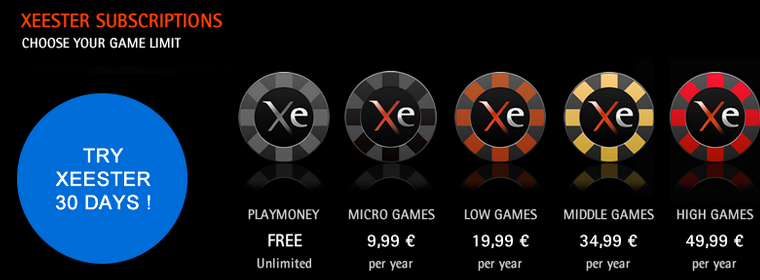
Installing the software is easy; the set-up required before you can start tracking your hands takes about five minutes.
Grade: A+
Having real-time information on your opponents is crucial to having the biggest edge possible when playing online. While it’s important to have this information available to you in a manner that is detailed enough to be useful, it’s also critical that it be done in a non-obstructive way. Xeester accomplishes both of these goals with a simple HUD interface that practically melts into the background:
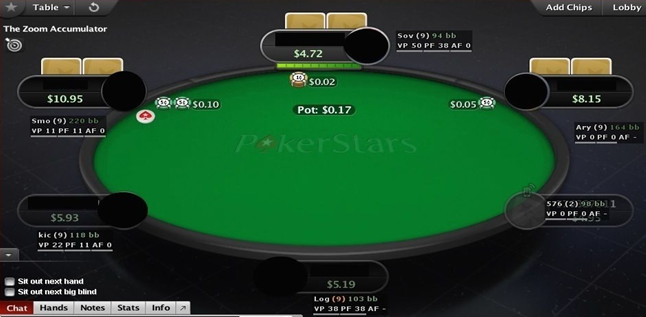
As you can see from the screenshot, the position of the HUD on the table is not set in stone, so you can put it where it’s most intuitive for you. Another great feature for those who are new to poker tracking software is that if you hover your mouse over a statistic you will get a quick description of what it’s measuring. Finally, you have access to additional statistics (no time to go through them all here, but they are very comprehensive) on an as-needed basis by double clicking the HUD. There is the option to expand the basic layout by adding more statistics, but this will of course make the HUD more obstructive on your table.
The range of fully customizable features is impressive and you can play around with what combination of utility and design works best for you.
Grade: B
Reviewing a hand as soon as it’s over is a great way to get instant reads on your opponents. It’s not uncommon for players to keep the hand replayer open during a session to allow them to take better notes or even zero-in on bet sizing tendencies. For that reason I feel this portion of the software is critical to effective poker software. While Xeester’s replayer is an upgrade from the ones that are native to most poker clients, I felt it was not nearly as user-friendly as the HUD:
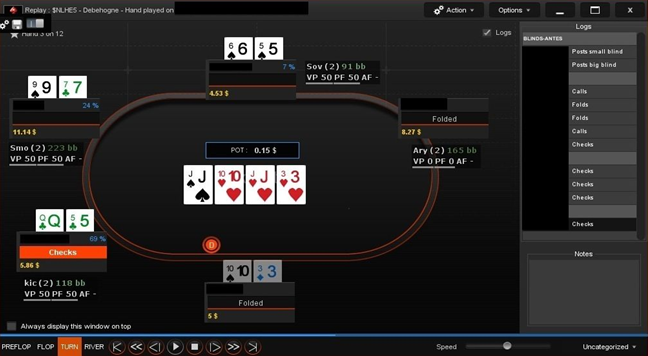
What’s great about this replayer is that you can set it to remain as the top window on your desktop. This prevents misclicks because a table won’t popup while you are using it. Another important feature is the availability of your HUD stats while doing review, as this will affect what notes you take. The option to take notes on opponents individually or the hand as a whole is also a great feature. It makes analysis more useful by allowing you to cross-reference notes on an opponent with how they behaved in an actual hand.
What didn’t I like? For starters, I’m not a huge fan of the card graphics here. They are flat and just not visually compelling (Note: I only used the trial version, so it’s possible others are offered in the paid one). Nitpicking aside, however, the controls are very small and the multiple buttons with similar looking arrows on them were not intuitive to me (they let you move forward/backward in the replayer by streets in a hand or from hand to hand). A lack of visual “chips” being bet and building a pot (you can see above that it simply says “POT” with a value) also made it more difficult for me to get a visually coherent picture of how a hand had played out.
The bottom line is that unlike the excellent HUD, I did not feel comfortable using this hand replayer immediately after opening it. It took much longer than it should have for me to get the feel of the design and be able to follow the action. Even after several hours, I found myself opening the native PokerStars replayer if there was a hand I wanted to review. Xeester’s replayer simply required too much concentration to be a viable in-game option for me.
However, away from the table it provides great opportunities to probe your opponents tendencies via notes and integrate your conclusions for easy reference during future sessions. For that reason, I think it does have a lot of value during study sessions away from the table.
Grade: A-
That’s a great transition to another key component of poker tracking software: study and review. Improving at your game means working at your game, and Xeester definitely does a good job at this. The interfaces for scrolling through your database or getting an overall visual picture of your game or your opponent’s game are very well done. They reduce clutter and allow you to really focus on key details in strategy:
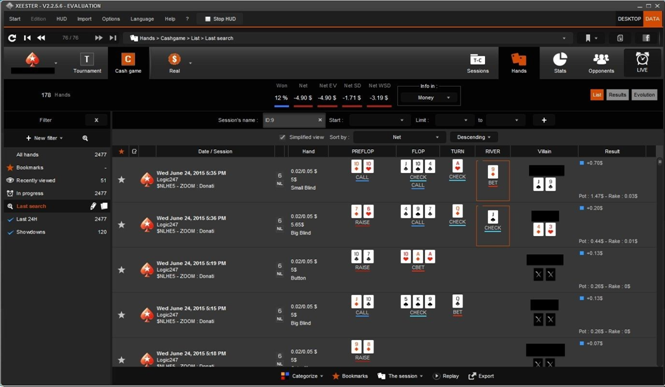
If you look in the top right corner of the screenshot you’ll see that there are four broad categories:
Breaking the data down in this way makes it easy to approach your analysis efficiently. If you had a bad session you can review it; if there were some problem hands you really want to go in-depth with you can find them easily; if you want to do big picture statistical analysis it’s right there; if you want to break down your opponents’ games for the next time you see them at the table, you can do that too.
All the information is right there at your fingertips. When you go into any of these categories, you’ll find that they can be broken down even further so you can really get at exactly what you are looking for. Also, the presentation of information is very simple, making it easy to understand and review:
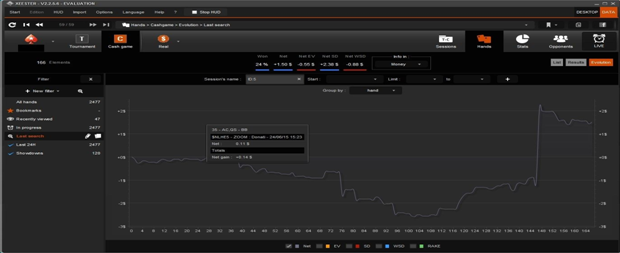
For example with this graph you can see at the bottom that there are five different options for breaking the same data down. You can show one of them, all of them, or anything in between. This allows you to focus on a single statistic or make comparisons between several of them. This graph is just a basic one (money won/hands played) but your imagination is the only limit on what you can look at.
Xeester’s online poker tracking software allows you to generate charts and graphs breaking down 3-betting frequencies, looking at the effectiveness of River bluffs, or examining anything else you want to look at in a visual way.
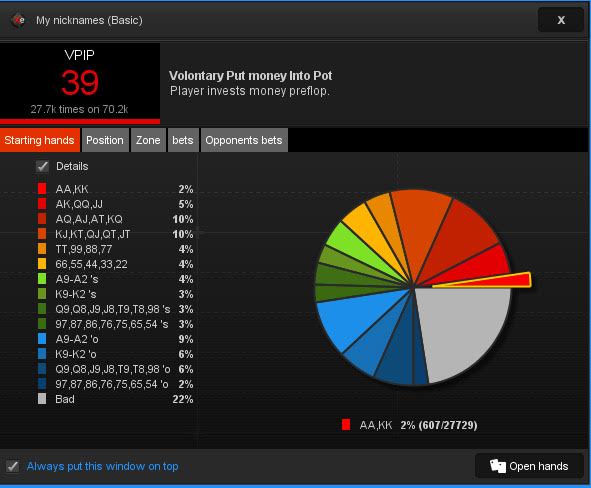
Xeester has developed a compelling and elegant poker tracking software. While it does have some flaws with the replayer, everything that you need is here. Whether you are a new online poker player just looking to start keeping track of your wins and losses, or a seasoned grinder seeking the tools for in-depth statistical analysis this program is more than up to the task of meeting your needs and expectations. You can download Xeester here.
Poker Night in America provided viewers with many great moments during the first 29 episodes that were aired during Season 1, so picking up the best moments from hours of poker fun was not an easy task. Furthermore, a list of the top five moments is obviously subjective, as not everyone is moved by the same things. With that said, I picked out the five moments below. For full coverage of all the episodes aired thus far, you can always visit the 888poker blog, where you can find them all nicely arranged in one place.

Yes, slow-rolling is bad; it’s bad poker etiquette and should be discouraged. But this particular hand between Mike Matusow and Shaun Deeb was simply too funny. Mike was already stuck for the night so Shaun may have pushed it too far when he took forever to call on the river with flopped quad fives.
Matusow wasn’t happy, to say the least, but the rest of the table seemed entertained. What Deeb did may not have been in the best taste, but seeing how Mike is a long-time veteran of the game, he shouldn’t have taken it to heart so much.

Read full episode 04 recap on 888poker
Danielle Anderson was a newcomer to the show in Episode 10 and her presence did not go unnoticed by the fans. In fact, she was voted the best overall player at the Golden Ace Awards ceremony, and it all started with this pot against Tom Schneider.
With both holding pocket pairs, Anderson’s pocket queens vs Schneider’s deuces, when the board came Q-5-2, the writing was on the wall it would be a huge pot. Another queen on the turn pretty much sealed the deal, giving Schneider a full house, and after she led out on both flop and turn, Anderson proceeded to check the river with her quads.
The river was pretty inconsequential 9, and after Danielle checked, Schneider naturally bet for value, only to be faced with a check raise for the remainder of Anderson’s stack. There was no getting away at that point and after he matched her river bet, Schneider’s could only watch a $10k pot shipped ‘Dmoongirl’s’ way. That’s what you call a good start!
Read full episode 10 recap on 888poker
Big pots are not easily created. It takes a player with a heart and commitment to try for a big bluff, or two big hands to collide. In the case of Tom Schneider and Al Adler, it was the latter, although Schneider had to catch a perfect runner-runner to get there.
On the flop, he had a measly top pair with mediocre kicker against Adler’s bottom set. However, the turn brought another 9, improving his hand to trips. A 10 on the river gave Schneider a better full house to take down Adler’s deuces full and win him a $15,000+ pot. Nothing else to say but “that’s poker”.
Read full episode 19 recap on 888poker
Whenever there was more than $15k in the middle, the odds are that it was an interesting hand. When such a hand also involved Eli Elezra, it gets extra points for entertainment value, as of us who enjoyed High Stakes Poker back in the day love seeing Eli back in action.
Elezra looked down to see pocket queens. To make things even sweeter, it was on his straddle. Greg Mueller, who initially opened to $400, makes a mistake thinking that Eli’s big raise is just a bluff in an attempt to protect his straddle and calls $2,000 on top of the raise and they go to the flop, which comes 3-3-7.

If Eli continued betting, that would probably be the end of it right there. However, he recognized that he had the board crushed and proceeded to check. Mueller checked behind with his KJ and after turn brought a J, it was time for Queens to get paid. Elezra made the most out of this hand, as he got Mueller to call both turn and river, raking in more than $16,000!
Read full episode 28 recap on 888poker
Having one Main Event champion at the table is great; having two of them at the same table at the same time is nothing short of awesome. Despite of what anyone may say (everybody’s a critic these days) both Greg Raymer and Joe Cada outlasted big fields to claim their WSOP Main Event titles.
In this particular hand, it was the two champs driving the action, but Raymer was the one raking in the chips in the end. It all started with ‘Fossilman’ limping in a straddled pot with pocket jacks and Cada making it $350 to go with Q9, both diamonds.

Three players in between made the calls and the action got back to Raymer who, it seems, wasn’t in a mood to take any flops. He put his entire stack of $4,250 in the middle. His opponents didn’t have good enough hands with which to make the call, with the second-best hand being pocket sixes. Greg raked in a nice pot uncontested, adding about 30% to his stack. Nice hand, sir!
Read full episode 23 recap on 888poker
Did any of the five moments I chose from season one of Poker Night in America make your list of favorites? Let us know your thoughts in the comments below.
There are few poker players in the world who need no introduction. Chris Moneymaker is one of those players. His legendary, groundbreaking win at the 2003 World Series of Poker Main Event was among the catalysts for the original poker boom and was directly responsible for millions of new players trying out poker for the first time. He memorably won a seat into the 2003 WSOP Main Event via a satellite event at PokerStars, which he still proudly represents today. Chris is also an ambassador for the Hollywood Poker Open, where he continues to represent the game we all love and draw in more new players all while ensuring they have a memorable, fun experience at the tables.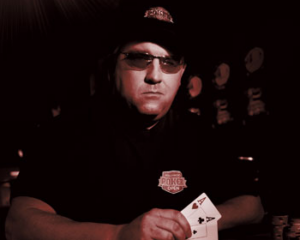
Editor’s Note: After having done interviews with Joe Hachem and Martin Jacobson, it’s especially gratifying to now be publishing our third interview with a World Series of Poker Main Event Champion. Thanks so much Chris for the opportunity.
This is Jon Sofen with CardplayerLifestyle.com. I’m joined by the 2003 World Series of Poker champion, Chris Moneymaker. He is an ambassador and the face of the Hollywood Poker Open [the Main Event of] which takes place in Las Vegas on June 26th at the M Resort. Chris, thank you for joining me, how are you?
I’m doing great Jon, thanks. How are you doing?
I’m doing good, thank you. I want to start out by talking to you a bit about the Hollywood Poker Open and your involvement. For those who don’t know, the HPO hosts tournaments all over the country throughout the year with the championship event in Las Vegas later this month. Chris, how many players are you expecting for the $2,500 championship event?
Last year we got around 700 players. I was the ambassador for Season 2 and we just wrapped up Season 3. We saw [year over year] growth at each stop, with the field pretty much doubling at each stop. So I expect us to get anywhere between 1,000–1,500 people in the main event. We’ve got a $2 million guarantee.
Being the ambassador for the Hollywood Poker Open, you are the face of the organization. Do you feel any pressure for the success of this poker tournament, which is now in its third season?
I don’t feel any pressure. I have a lot of input in terms of what goes on with the tour. After each season we sit down and brainstorm ideas and listen to player feedback. I look at our competitors in the market today and who we are competing against and I just see that we have better structure, better dealers, etc. So if players come out and play in our event, I’m confident in it. That’s why we’ve grown so much over the last two years. Everybody that comes out has a good time.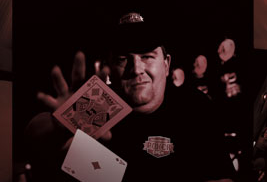
Our tour is a little bit different than some of the others. I just think it’s a bit more lighthearted; there’s a lot of chatter in the room. Even right down until deep into the money, most of us are still joking around. So it’s a much more fun experience, whereas if you look at some of the other tournaments everyone’s got their headphones on. I mean, there are guys who obviously take it really seriously, but for the most part our audience is guys in their mid-30s who come out and play and just want to enjoy themselves.
Our floor staff and dealers are top-notch, so I’m really happy with the product that we put out there. I believe it’s going to succeed. We’re late to the part as far as tournaments go, as we’re fighting against tournaments that have already been established, so we know that we have an uphill battle, but I think we’re winning the war and I hope that next year we’ll be even better.
We’re hoping to extend some of the series out into the fall and try to make it more of a year-round series. Right now, we’re very much a spring-type series, so next year I’d look for us to start out a lot earlier and run through the fall all the way up until and through the spring.
You’ve played in many big poker tournaments over the past dozen years. I myself just played at the WSOP for the first time and I cashed in the Colossus. So, for a player like myself, which is sort of the type of player you said you’re trying to attract, how does the HPO compare to, say, the WSOP and WPT in terms of entertainment value?
Well, first of all, you’re not going to have a three-hour wait to register for the event. They do a really good job with moving people. Even last year when we had 700 people, which was our biggest event of the year, there were hardly any lines. Restrooms, on breaks, were pretty easy to get in and out of. The things that you deal with at the World Series, you’re not going to have to deal with at our property.
A poker tournament is a poker tournament in general, but the fact that we give so many seats to slot players, to $1/2 players, to recreational players, it feel like a much more engaging, festive, people who are there for the first time in Vegas-type of experience. The level of play is similar to what you might find at the Colossus. There’s a good mix of pros and amateurs. It’s really similar to what you’d find play-wise at an up to $1500 buy-in event at the World Series of Poker except that you’ll get 2,500 in chips and the structure is going to be better than what you would be playing at any WSOP event.
Holding the HPO Main Event at the same time that the World Series is going on – was that a strategic decision? Do you think you get more players because more people are in town or does the WSOP going on during this month actually hurt attendance?
I don’t think it hurts attendance at all. There are so many poker players out in Vegas during this time and a lot of them just can’t afford the $5,000 and $10,000 price points that you run across at the World Series all the time. A lot of other places have tournaments going on at the time; there’s a lot of choices when it comes to tournaments at that time. We chose a weekend that I think it’s the Seniors event, if I’m not mistaken.
We specifically chose a date that there’s no Millionaire Maker or Colossus event going on which gives us the best opportunity to get those players. It’s a good rest stop; you get out of the Rio, you get away from the Strip to a different environment. It’s definitely a good break and I think we all feel it’s a good fit for this time of year. We might move it to the fall for next year, but I think the placement of it is good as far as the time. Again, we’re open to anything that our player feedback gives us in order to give them the best experience and us the best numbers. Everyone has been happy with the finals, we’ve gotten some very good numbers, so I expect the main event to have some really good numbers.
Right, so obviously the 2003 Main Event title is what you’re most known for. Your heads-up opponent, Sam Farha said years ago your big bluff was the ‘worst bluff of the year’. It’s been 12 years since that day and you’re probably not the same poker player as you were back then. Do you now consider it too risky of a play or would you still make that play in that situation today?
I would still make the play I made just for the dynamics of the play. There’s a lot that went into it. Now I’m 10 times the poker player I was back then; if I wasn’t I wouldn’t be playing… I mean, everyone’s gotten better. Given the fact that he thought he was that much better than me and wanted to play small ball and really grind me down…
Sammy‘s a longball player and he likes to play big pots. But given the experience factor, he knew he could wear me down, which was pretty accurate. He just didn’t want to be risking his tournament life without a made hand. He didn’t want to go down getting eliminated from the Main Event calling with one pair. I really had a feeling that wasn’t going to be his MO. He knew he got bluffed and I knew he was steaming. I knew that during the next five hands if I picked up a hand, you could just read it on his face, he was ready to explode. Basically, I thought it was a good play.
If you had put him on top pair, would you still make that play?
Yeah, I believe so. I mean, I put him on middle pair with like the ace of spades. Back then you never really assigned ranges to people, you just sort of put someone on a specific hand and went with it. I knew he didn’t have a flush or straight and that he didn’t want to go broke to an amateur on that stage. Him making that call and being wrong is a lot worse for him than folding and being right. It was a different game back then. Today’s game, how I played the hand, most people would’ve looked me up. I’d play it differently now. But it was a good play for that moment in time.
If Farha calls that bet, how much different is poker’s popularity right now?
Well, that depends. If he calls, he’s got a 2:1 chip lead, but he still hasn’t knocked me out. I’d have an uphill battle, but it wasn’t over yet. Poker has obviously grown. I think you might still be able to play online poker, it wouldn’t have grown as fast. Maybe we’d see more of a gradual growth rather than the explosion we saw in ’03. Everyone has figured it out that poker is a great game.
Maybe Raymer would’ve been you?
Well, I don’t know. I mean, the year before I won an amateur named Robert Varkonyi won and there was no poker boom. I think the thing was that people really just didn’t relate to him. He was an MIT guy.
Greg is one of my best friends, but I think he also sort of falls into that category; he’s a smart guy, much smarter than me; he’s a patent attorney. I just sort of relate better to your average, everyday person. People who saw Varkonyi or Raymer win, maybe they’re thinking you need to be really intelligent. But you look at me and you see some old hick from Tennessee.
Have you played with or bumped into Farha much over the years since the 2003 Main Event?
I played with him one time in a PLO cash game for about 10 minutes, then he had to take off and go somewhere. We then had our rematch several years later.
We did a charity event up in New York together, spent a lot of time together and hashed out our differences. We’re not friends but we’re not enemies. There was mutual respect there. There wouldn’t be my moment in time like that without Sammy. Sammy played the villain perfectly. Tomer Benvenisti, even Dan Harrington… they didn’t look the part. Sammy was old Vegas.
I’m going to put you on the spot here. Who is the best poker player to win the Main Event since and including 2003?
Haha. It’s obviously Chris Moneymaker. Seriously though, I’d have to pick Greg Merson. He’s a heck of a player. He was a good online player and a good cash game player; just a good overall player.
You obviously are and will always remain a big name in poker because of how your Main Event title spiked the poker boom. I think everyone in the poker community acknowledges what your win meant to the game’s popularity. But do you feel the top poker players in the world don’t give your poker game enough respect?
Not really. If they don’t, I don’t really care. I’ve never considered myself a full-time poker player; I’ve never traveled the circuit. I mean, they’re all out playing at the World Series right now. I’m sitting here changing a diaper J. Overall, I’m happy with the decisions I’ve made though. There aren’t many people in poker who have families. Phil Hellmuth is probably one of the few professional poker players who is married and has a successful relationship. It’s not easy to find a woman who’s onboard with all the commitments required of a professional poker player.
So winning more titles at the WSOP or the WPT, is that important to you?
Honestly, no. I’m a competitive person, no matter where I play, be it a freeroll or the main event. I don’t have a life goal to win another bracelet or anything like that. If I did, I’d be out in Vegas working towards that goal. Honestly, my goal is to be a good husband, be a good dad, bring up good kids, and enjoy life as much as I can. Part of that enjoyment is playing poker on my own schedule, when I want to. If I had to go and play every single day, I wouldn’t be a very happy individual.
Eric Raskin released The Moneymaker Effect last year – for those who aren’t aware, it’s an oral history of the happenings surrounding Chris’ Main Event win back in 2003. Robbie Strazynski, founder of Cardplayer Lifestyle, actually reviewed the book last year. Chris, what’s your take on that book?
I read some of it, not the whole thing. It sounds like he really went out and got a lot of different perspectives on it. He interviews people who I wouldn’t even think to interview. He gives a good broad picture on what was going on at the time, what poker was like, and you can see the huge contrast between what poker was like back in 2003 and what it’s like today. You can see what people thought about me and how that’s different from how I see myself.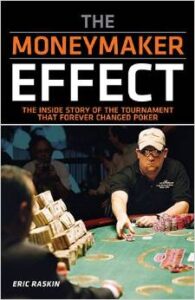
I think many of our readers and listeners want to know, which WSOP events do you plan on playing this year?
I haven’t even looked at the schedule yet. Well, I’m flying out to California to promote online poker for PokerStars on June 22nd. I fly from there to Vegas on the 23rd. So I’ll have two days before I play the HPO main event on the 26th. That whole weekend is pretty much dead, but thereafter I’ll probably play in a couple of events over the following few days. I won’t be playing in the $111K event though. I have no equity in that tournament. If I don’t play a single WSOP event because I think there’s better value at the Golden Nugget, I’ll go to the Golden Nugget.
Obviously July 5th I’ll be at the Rio playing Day 1 of the Main Event.
Has your poker interest declined or grown over the years?
I think it declined a bit at first and then it’s gone back up over the years. I think the HPO has a lot to do with it. I can decide to play whenever I want now, which is just great. If I had to go and play at the Rio or on the circuit, I just wouldn’t enjoy it. All those people with their 5-betting and headphones; that stuff just isn’t fun. Poker is supposed to be fun, something where you interact with people at the table and vice versa.
On behalf of Cardplayerlifestyle.com, I’d like to thank you for chatting with me today, Chris. Good luck at the Hollywood Poker Open Main Event and at the WSOP. I’ll see you at a final table somewhere soon, but I should warn you. I’m not going to fold my pair of 9s when you brick the river.
Hehe, well, I’m not gonna chop either. 🙂 Take care.